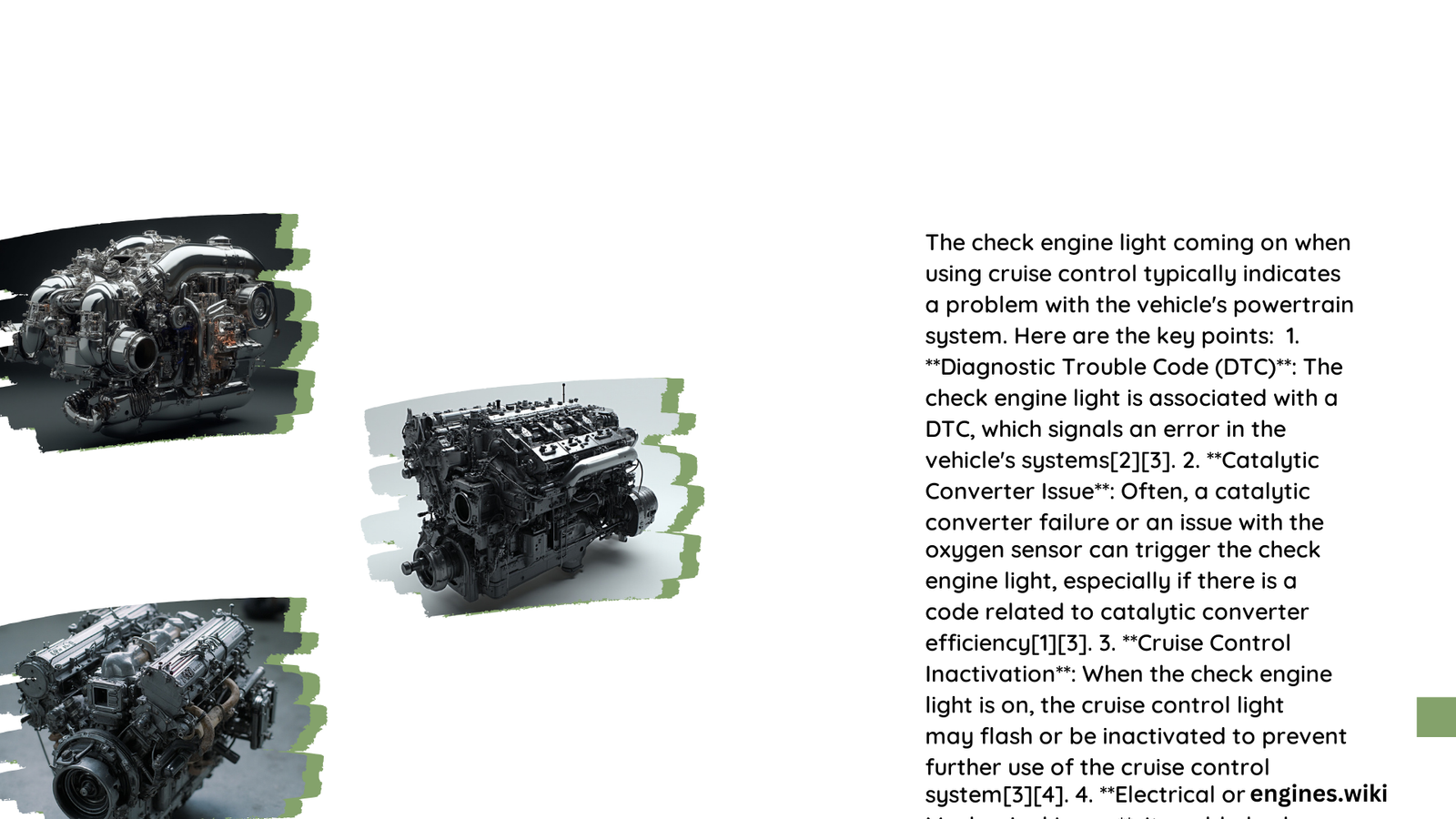When the check engine light illuminates while using cruise control, it often indicates an underlying issue with the vehicle’s systems. This problem can stem from various sources, including faulty sensors, electrical issues, or more serious engine or transmission problems. Understanding the potential causes and diagnostic procedures can help drivers address the issue effectively and ensure their vehicle’s optimal performance and safety.
Why Does the Check Engine Light Activate During Cruise Control?
The check engine light activation during cruise control use can be attributed to several factors:
- Sensor malfunctions
- Electrical system issues
- Engine or transmission problems
- Cruise control system faults
Each of these potential causes requires specific diagnostic approaches and may have varying impacts on vehicle performance and repair costs.
What Are the Common Causes of This Issue?

Faulty Brake Light Switch
A malfunctioning brake light switch can disrupt the cruise control system’s operation and trigger the check engine light. This switch is crucial for detecting brake pedal engagement, and its failure can cause the cruise control to deactivate unexpectedly.
Blown Fuse
A blown fuse in the electrical system can disable the cruise control and activate the check engine light. Checking the fuse box, typically located in the trunk or glove compartment, is a straightforward initial diagnostic step.
Vehicle Speed Sensor Malfunction
The vehicle speed sensor plays a vital role in maintaining the set speed for cruise control. If this sensor fails, it can cause cruise control malfunction and trigger the check engine light. Error codes related to speed sensor issues often include P0500 (Vehicle Speed Sensor Malfunction).
Electrical Wiring Issues
Faulty wiring or connectors can disrupt power supply to the cruise control system, leading to its failure and potentially activating the check engine light. Diagnostic tools like multimeters can help identify electrical anomalies.
Engine or Transmission Problems
Serious issues with the engine or transmission may cause the Electronic Control Unit (ECU) to disable non-essential systems like cruise control to prevent further damage. This can be indicated by various check engine light codes, such as those related to the evaporative emission control system (e.g., P0442 or P0456).
How to Diagnose the Problem?
To diagnose the issue when the check engine light comes on during cruise control use, follow these steps:
- Use a scan tool to retrieve error codes from the ECU
- Inspect the fuse box for blown fuses related to the cruise control system
- Check electrical wiring and connectors using a multimeter
- Perform a smoke test if evaporative emission control system leaks are suspected
- Test the brake light switch functionality
- Verify the vehicle speed sensor operation
What Are the Specific Error Codes to Look For?
When diagnosing this issue, pay attention to these error codes:
| Error Code | Description |
|---|---|
| P0500 | Vehicle Speed Sensor Malfunction |
| P0442 | Evaporative Emission Control System Leak Detected (Small Leak) |
| P0456 | Evaporative Emission Control System Leak Detected (Very Small Leak) |
These codes can provide valuable insights into the underlying cause of the problem.
What Tools Are Required for Diagnosis?
To effectively diagnose the issue, you’ll need the following tools:
- Scan tool or code reader
- Multimeter
- Smoke machine (for detecting evaporative system leaks)
- Basic hand tools for accessing fuses and electrical components
How Does This Issue Impact Vehicle Performance?
The impact on vehicle performance can vary depending on the root cause:
- Cruise control failure: Inconvenience during long drives
- Engine or transmission issues: Potential impact on overall vehicle performance and safety
- Sensor malfunctions: May affect fuel efficiency and engine performance
What Are the Estimated Repair Costs?
Repair costs can vary widely based on the specific cause:
- Fuse replacement: Generally inexpensive (under $50)
- Speed sensor or brake light switch replacement: $100 to $500
- Evaporative emission control system repairs: $500 to $2,000 or more
- Engine or transmission repairs: Potentially $1,000 to $5,000 or more
Are There Any Manufacturer-Specific Issues to Consider?
Some manufacturers may have specific service bulletins or recalls related to cruise control and associated systems. For example:
- Subaru has issued bulletins regarding evaporative emission control system updates that can affect cruise control operation
- Certain vehicle models may have known issues with speed sensors or brake light switches that can impact cruise control functionality
Always check for any manufacturer-specific information related to your vehicle make and model when addressing this issue.
How to Prevent Future Occurrences?
To minimize the risk of future check engine light activations during cruise control use:
- Regularly maintain your vehicle according to the manufacturer’s schedule
- Address any warning lights or unusual behavior promptly
- Keep electrical systems in good condition
- Use high-quality replacement parts when repairs are necessary
By following these preventive measures and understanding the potential causes of check engine light activation during cruise control use, you can ensure a smoother and more reliable driving experience.
References:
1. Custom Complete Automotive: 5 Reasons Why Your Cruise Control is Not Working
2. Santa Cruz European Auto: Four Reasons for Cruise Control Failure in Your Car
3. Car Talk Community: Check engine light associated with cruise control use
